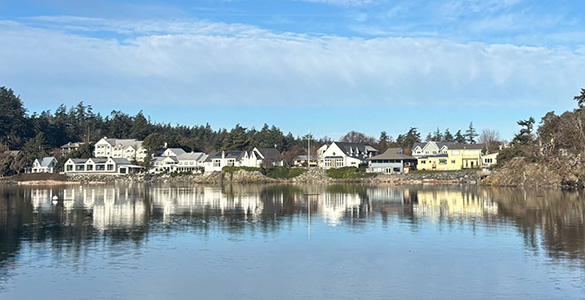— from Katie Jones, Center for Whale Research–

As an educator, I am always looking for ways to relay good stories to people while also delivering facts about this very special, very critically endangered population of killer whales. Stories are one of the best ways to help form an emotional attachment for people that might otherwise know nothing about Southern Resident killer whales, and of course, people that do know these whales intimately can’t get enough stories about a favorite whale. These whale tales help turn people into advocates, and at this point, the Southern Residents need all the friends they can get!
A few weeks ago, I was watching the J16 family group forage off the south end of San Juan Island. J26—Mike—was one of the whales we were spending time with. As we watched Mike methodically surface with his mother, J16—Slick—I told the people that I was gathered with about him and the reason behind his name. This isn’t just “some” whale you are having the opportunity to see – this is MIKE!
People were enamored by his big, tall dorsal fin, his explosive breaths, and the apparent close relationship with his mother as they swam side by side breathing in synchrony. People were silent, still, and transfixed. The whales may not have been doing anything incredibly exciting that afternoon, but it didn’t matter. The story helped to keep everyone’s attention, and I think by the end of the encounter, people will always remember that they saw Mike.

J26 was born in 1991 and was the first-born to J16 (est. birth year 1972). He has two living younger siblings, J36 (born 1999) and J42 (born 2007), and three younger siblings and a nephew that are deceased, J33 (1996-2010), J48 (born 2011 and did not survive the year), J50 (2014-2018), and nephew J52 (2015-2017, son of J36). Like all male orcas, J26 had a shorter dorsal fin until he reached his young teenage years and went through a noticeable growth spurt.
We call young males in their teenage years “sprouters” because their fin is starting to sprout and grow taller. Males really aren’t fully mature until they are in their late teens or early 20’s. J26 will be twenty-nine years old this year, and even though he’s a full-grown adult male, like all resident orcas, he maintains a close relationship with his mother and his siblings, and they are almost always seen swimming near one another. In fact, they tend to be a rather independent little matriline within J pod; sometimes, they spend days at a time miles apart from the rest of the pod, but they always seem to join back up together eventually.
One of my most memorable encounters with J26 was in May of 2007. It was one of the first encounters we ever had with J42.
The whole family seemed so excited that day. J16 and J26 were being so tactile with the new baby, sandwiching her and lifting her out of the water. J36 was doing everything she could to get closer to her new little sister, but she couldn’t quite seem to squeeze in between her mom and her brother. J26 seemed so elated. He breached multiple times that day, and there seemed to be such a sense of joy. That will forever remain one of my most memorable encounters.
Center for Whale Research senior staff member Dave Ellifrit recalled one of his encounters with J26 when he was just a young whale. J16 had been lying on the surface one day trying to rest. J26 was being rather rambunctious as young whales can be, and was seen relentlessly pestering his mother with his antics. At one point, J16 grew weary of her young son’s rowdy behavior so much so that she reared up vertically and whacked him with her head!
One of my more recent favorite encounters with J26 happened in the summer of 2016. We were with J26 and J50 off Turn Point on Stuart Island. The rest of the J16’s were much farther to the south. Little J50 seemed to be having a blast carrying bull kelp around in her mouth, and her big brother was right there next to her joining in with the game, pushing bull kelp with his rostrum and letting it drape over his back and pectoral flippers.
While many people may know and adore Mike, the whale, what about the man for whom J26 is named? Pre-1960’s very little was known about killer whales. Many people regarded them with disgust. Some viewed them as pests and had incorrect notions of the animals being vicious monsters. It wasn’t until killer whales began to be captured for the aquarium industry that we began to learn more about them. We came to understand that these animals are not vicious, but instead are very intelligent, family-oriented creatures.
One of the other arguably unfortunate things people learned about orcas during this time was the fact that they were also trainable and could be taught to do tricks. It was then that aquariums around the world wanted orcas in their tanks and would pay top dollar to acquire them. It didn’t take long for orca captures to become big business in the Pacific Northwest. After a number of years, governments on both sides of the Canadian/US border became concerned about the number of whales being seized from Northwest waters. Is the capture of orcas sustainable? What is the total number of orcas inhabiting these waters?
And here we arrive at the beginning of modern orca research! The Department of Fisheries and Oceans Canada (DFO) hired Dr. Michael Bigg to investigate the answers to these questions and begin a population census. In 1971, Dr. Bigg started a sightings program in which he sent questionnaires regarding locations and the number of orcas seen to lighthouses, fishermen, ferries, tugs, etc. During the assessment of the approximately 500 questionnaires returned, Dr. Bigg estimated that the British Columbia population was quite small, perhaps only 200-300 animals, which was much less than initially thought.
In 1973, Dr. Bigg made the suggestion that using photographs to identify individual orcas could be significantly useful, in particular photographing the dorsal fin and saddle patch of each whale, which is unique on each animal. There were definitely people that were skeptical of Dr. Bigg’s photo ID technique. In order to prove his idea, two notches were carved out of the top of the dorsal fin of a male orca that was captured in Pedder Bay near Victoria, British Columbia in October of 1973. This orca, known as K1, retained the notches for the duration of his life and proved that photo ID was a sound identification method.

Over the coming years using this technique, Dr. Bigg began to assign identities to each orca. Each pod he came upon was given a letter (A, B, C, etc.). And each individual in the pod was given a number.
Michael Bigg was primarily a pinniped researcher for DFO, but never strayed from his interest in killer whales, doing much of his killer whale research in his spare time after the initial study had concluded. He spent nearly two decades making significant advancements in killer whale research along with his colleagues: Ken Balcomb, John Ford, and Graeme Ellis, to name a few. Mike was always willing to cooperate with anyone working in the field in order to help the advancement of knowledge of these amazing animals. After all, the animals could be dispersed over huge areas. The more eyes, the better!
Dr. Bigg is considered among many to be the father of killer whale research. His photo identification methods to track the population dynamics of killer whales was pioneering and is now used to study other populations of killer whales and other animals as well. How amazing to have such detailed information on specific populations of animals and even more amazing that within a relatively short amount of time, Dr. Bigg had photographed and alpha-numerically named every individual in the Northern Resident and Southern Resident populations, and many animals within the Transient* killer whale population!
Tragically, Dr. Bigg succumbed to leukemia in October of 1990 at the young age of fifty-one and left a gaping hole within the whale research community. However, his trailblazing research methods will forever continue to be relevant and vital in the study of killer whales.

The day J26 was first seen, he was sighted with his mother off of False Bay in the Fall of 1991. He was a very new baby, and at one point during the encounter, J26 rolled over with his belly to the surface. It was noticed that part of the umbilical cord was still attached, and he was definitely a male. Dr. Michael Bigg had just passed away recently, and Ken Balcomb pointed to the new baby and exclaimed: “MIKE!”. The rest is history, as they say, and J26 continues to be one of the most iconic individuals within the Southern Resident killer whale community. He lives on with a name that is in honor of the memory of the amazing man who started it all.
*Transient killer whales are also known, and now commonly referred to, as Bigg’s killer whales—in honor of Dr. Michael Bigg.
**If you are reading theOrcasonian for free, thank your fellow islanders. If you would like to support theOrcasonian CLICK HERE to set your modestly-priced, voluntary subscription. Otherwise, no worries; we’re happy to share with you.**








What a wonderful story to read tonight, Katie while my TV is not working. And so delightfully written. Bring on more stories, Orcas Issues